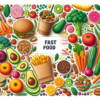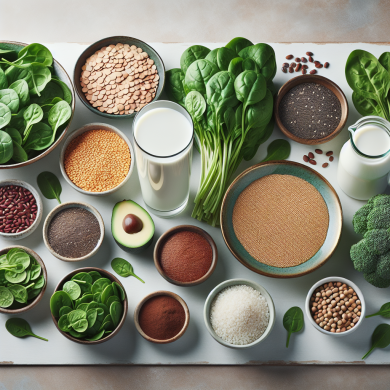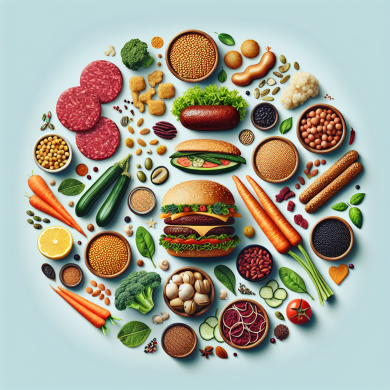Boost Health with High-Fiber Vegetarian Foods
Introduction
In an era where health and wellness are of paramount importance, dietary choices play a crucial role in maintaining a robust lifestyle. Among the various dietary components, fiber stands out for its multifaceted benefits. High-fiber vegetarian foods, in particular, offer a myriad of health advantages that can significantly enhance overall well-being. This article delves into the benefits of high-fiber vegetarian foods, explores a variety of options, and provides practical tips on incorporating them into your daily diet.
What is Dietary Fiber?
Dietary fiber, often referred to as roughage, is a type of carbohydrate found in plant-based foods that the body cannot digest. Unlike other carbohydrates, fiber passes through the digestive system relatively intact, aiding in digestion and contributing to various health benefits. There are two primary types of fiber: soluble and insoluble.
Soluble Fiber
Soluble fiber dissolves in water to form a gel-like substance. It helps lower blood cholesterol and glucose levels. Foods rich in soluble fiber include oats, peas, beans, apples, citrus fruits, carrots, and barley.
Insoluble Fiber
Insoluble fiber does not dissolve in water and adds bulk to the stool. It aids in the movement of material through the digestive tract and increases stool bulk, which is beneficial for those struggling with constipation or irregular stools. Whole grains, nuts, beans, and vegetables like cauliflower, green beans, and potatoes are good sources of insoluble fiber.
Benefits of High-Fiber Vegetarian Foods
Incorporating high-fiber foods into a vegetarian diet can have numerous health benefits:
Improved Digestive Health
Fiber is essential for maintaining healthy bowel movements. It increases the weight and size of your stool and softens it, making it easier to pass and reducing the risk of constipation. A diet rich in fiber can also help prevent intestinal blockages and reduce the risk of developing diverticular disease, which are small pouches that can form in the walls of the digestive tract.
Heart Health
A high intake of fiber, particularly soluble fiber, is linked to a lower risk of cardiovascular disease. Fiber helps reduce blood pressure, improve cholesterol levels, and reduce inflammation, which are critical factors for heart health. Soluble fiber can help lower total blood cholesterol levels by lowering low-density lipoprotein or “bad” cholesterol levels.
Weight Management
High-fiber foods tend to be more filling than low-fiber foods, which can make it easier to eat less and stay satisfied longer. This can aid in weight management by preventing overeating and reducing overall calorie intake. Additionally, high-fiber foods often require more chewing, which allows more time for the body to register feelings of fullness.
Blood Sugar Control
For individuals with diabetes, fiber can help slow the absorption of sugar and improve blood sugar levels. A diet that includes insoluble fiber has been associated with a reduced risk of developing type 2 diabetes.
High-Fiber Vegetarian Foods to Include in Your Diet
To maximize the health benefits of your diet, consider incorporating the following high-fiber vegetarian foods:
Legumes
- Chickpeas: Rich in protein and fiber, chickpeas are versatile and can be added to salads, stews, and soups.
- Lentils: Available in various colors, lentils are high in fiber and protein, making them a great meat substitute.
- Black Beans: Known for their rich flavor, black beans are high in fiber and can be used in a variety of dishes from salads to burritos.
Whole Grains
- Quinoa: A complete protein, quinoa is high in fiber and can be used as a base for salads or as a side dish.
- Oats: Ideal for breakfast, oats are high in soluble fiber and can help lower cholesterol.
- Brown Rice: A healthier alternative to white rice, brown rice is rich in fiber and essential nutrients.
Nuts and Seeds
- Chia Seeds: Packed with fiber, chia seeds can be added to smoothies, yogurt, or used to make puddings.
- Almonds: High in healthy fats and fiber, almonds make for a nutritious snack.
- Flaxseeds: Ground flaxseeds can be added to baking recipes or sprinkled over cereals for an extra fiber boost.
Fruits and Vegetables
- Apples: A convenient and portable source of fiber, apples are great for snacking.
- Broccoli: High in fiber and vitamins, broccoli can be steamed, roasted, or added to stir-fries.
- Avocados: Besides being a source of healthy fats, avocados are also high in fiber and can be added to salads or toast.
Practical Tips for Increasing Fiber Intake
Incorporating more high-fiber foods into your diet can be simple and enjoyable with these practical tips:
Start Gradually
To prevent digestive discomfort, gradually increase your fiber intake over a few weeks. This allows your digestive system to adapt to the change.
Stay Hydrated
Fiber works best when it absorbs water, so ensure you drink plenty of fluids throughout the day to help the fiber move through your digestive system.
Experiment with Recipes
Try new recipes that incorporate high-fiber foods. Experiment with different grains, legumes, and vegetables to find combinations you enjoy.
Snack Smart
Choose high-fiber snacks like fruits, vegetables, nuts, and whole-grain crackers to keep you satisfied between meals.
Read Labels
Check the nutrition labels on food packaging to identify high-fiber options and make informed choices.
Conclusion
Incorporating high-fiber vegetarian foods into your daily diet is a powerful way to boost your overall health. From improving digestive health to supporting heart health and aiding in weight management, the benefits of fiber are vast and well-documented. By making small, gradual changes to your diet and embracing a variety of high-fiber foods, you can enjoy delicious meals while reaping the numerous health rewards that come with a fiber-rich diet. With a little creativity and planning, you can transform your diet into a powerhouse of nutrition, promoting a healthier and more vibrant life.















Add comment